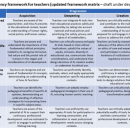
3888952 (CC0), Pixabay
Been a while since I last posted here. It i s not that I have been inactive - far from it. It is just that either everyone else seemed to be saying what I wanted to say - and usually better and the strangely unsettling effect of the lockdown in Spain.
Any way I am back here writing again and with a lot of things to talk about.
One area of my work is the provision of Labour Market Information to support careers guidance, primarily in the UK. And just as in other areas of education careers guidance is fast moving online. However providing access to data about the jobs of the future is not an easy business. on the LMI for All database which I work with, only two months ago we published an update of our 'Working Futures' data, with projected employment up to 2030 in different jobs. Interestingly, it is the most popular of the ten or so different data sets we provide. But I seriously wonder how accurate that data is any longer.
I have been to a number of webinars about the future of employment and there is increasingly data and analysis coming out. I think one of the unknown factors (leaving aside the question of when a vaccine for Covid 19 might be available) is government policies and reactions to the deep recession sparked off by the pandemic. Policy not only includes direct support to industries, enterprises and individuals but also how the broader economy is regulated in the future (more on this in a future post).
Some of the best analysis of the labour market I have seen (at least for the UK) is from the Centre for Cities. In an article entitled "What does the C0vid 19 crisis mean for the economies of British cities and large towns?" they report that the impact of the pandemic varies in different locations.
- Sales at non-grocery suppliers fell by around 45 per cent, compared to the same week of last year. Spending at grocery suppliers rose by 16 per cent, as people eat more at home.
- Pretty university towns and cities have been hit twice – they have lost their students and their tourists. Oxford and Brighton saw massive spending falls – plummeting around 60 per cent compared to the same week last year;
- The biggest falls have come in smaller tourist towns. Excluding grocery spending, Penrith in Cumbria has seen spending fall 82 per cent fall. Penzance, in Cornwall, has seen an 85 per cent drop;
- The big cities have all suffered, but with significant variation. Leeds, Cardiff and Liverpool are down more than 30 per cent, but have done better so far than Sheffield and Nottingham – both down by around half;
- London sales are down by 29 percent overall, but its figures are flattered by being a financial centre. Outside of the centre, spending is down by 40 per cent.
- Areas with strong retail and wholesale industries, such as Peterborough, have also seen serious declines. Areas with lots of employment in coffee shops, restaurants and sports have also seen particular falls in sales – as have the areas around airports.
- Local customers are critical. The strongest predictor of how well a neighbourhood’s businesses will do is what share of its old customer base lived nearby. Shops that rely on customers who travel more than a mile to get to them are doing worse.
The article draws particular attention to what they call the 'localisation effect'. Quite simply how well or badly shops and businesses are doing depends on the percentage of their customers who live locally. Looking on from Spain, I wonder how much the move to out of twon shopping has effected the UK, where high streets were already in trouble before the lockdown. In Spanish cities the housing density is usually higher, with local shops and markets in easy reach for most purchases and probably more likely to survive. On the other hand the large numbers of small bars and terraces are being devastated by the crisis.
Anyway much more to come on this theme in next couple of weeks.








